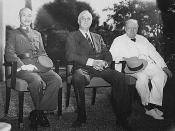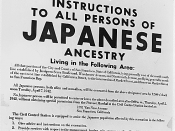"...the Japanese had been welcomed at first as a source of cheap labor, but shortly thereafter, became targets of anti-Asian campaigns, maligned as the "yellow peril." They inherited much of the new prejudice directed previously against the Chinese, especially as the Japanese moved from itinerant farm laborers to become owners of farms and small businesses." (Jainternment).
Throughout the United State's history different ethnicities have been targeted by discrimination. What happened to the Japanese during World War II is no different; many Japanese and Japanese-Americans were discriminated against after Pearl Harbor was bombed on December 7, 1941.
On February 19, 1942, soon after the beginning of World War II, Franklin D. Roosevelt signed Executive Order 9066. The evacuation order commenced the round-up of 120,000 Americans of Japanese heritage to one of 10 internment camps officially called "relocation centers" in California, Idaho, Utah, Arizona, Wyoming, Colorado, and Arkansas. Roosevelt's executive order was fueled by anti-Japanese sentiment among farmers who competed against Japanese labor, politicians who sided with anti-Japanese constituencies, and the general public, whose frenzy was heightened by the Japanese attack of Pearl Harbor.
More than 2/3 of the Japanese who were interned in the spring of 1942 were citizens of the United States.
The U.S. internment camps were overcrowded and provided poor living conditions. "Many families lived in horse stalls under unsanitary conditions, often by open sewers. Others occupied hastily constructed barracks. Toilet and bathing facilities were communal and devoid of privacy. Barbed wire fences and armed guard towers with guns facing toward the inmates surrounded these compounds. They were, in fact, prisons." (Jainternment).
By the end of 1942, as challenges to the constitutionality of the internment made their way to the U.S. Supreme Court, the WRA announced a policy of "relocation" of Japanese American internees. By the middle of 1943,


